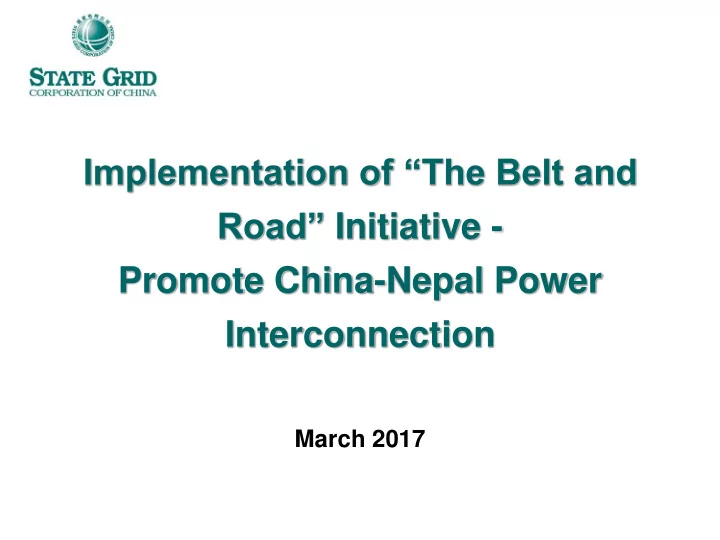

Implementation of “The Belt and Road” Initiative - Promote China-Nepal Power Interconnection March 2017
2 3 2
Global Energy Interconnection (GEI) In September, 2013, the Chinese Government proposed “ the Belt and Road Initiative ” that focuses on infrastructure connectivity among countries along the route to promote economic prosperous and regional economic cooperation of these countries. In September, 2015, the Chinese President Xi Jinping proposed discussions on establishing Global Energy Interconnection, or GEI , to facilitate efforts to meet global power demands with clean and green alternatives at the UN Sustainable Development Summit. Initiated by the State Grid Corporation of China, the Global Energy Interconnection Development and Cooperation Organization, or GEIDCO , was founded in March 2016, and has gained active response from the international community. Working closely with relevant countries, companies, research institutes and organizations, the GEIDCO published “ White Paper on Global Energy Interconnection Development Strategies”, “ Technology and Prospects for Cross-regional Power Networks”, and “Global Energy Interconnection Development and Outlook 2017 ” in February 2017, building common consensus to promote GEI development. 3
Global Energy Interconnection (GEI) GEI is globally interconnected strong and smart grid with UHV grid as the backbone, an infrastructure platform on which clean energy can be developed, transmitted and used massively worldwide. In essence, GEI is “Smart Grid + UHV Grid + Clean Energy” . GEI could serve safe, reliable, low-carbon global energy platform with extensive service coverage and strong allocation capacity. 4
Global Energy Interconnection (GEI) The development of GEI can be divided into three phases, including domestic interconnection, transnational interconnection and transcontinental interconnection. The Establishment of GEI will realize the target of limiting the global temperature increase to 2 ℃ . Till 2050, the proportion of clean energy will reach 80% Equivalent to 24 billion tons of standard coal per year Replacing fossil energy Emission reduction 670 billion tons of CO 2 emissions reduction Global Carbon Emission Less than 11.5 billion tons, half of the emission in 1990 Power grids of different continents with time difference and seasonal difference can be interconnected, reducing energy costs and improve economic efficiency. By 2050, the investment for GEI construction will be more than 100 trillion US dollars, generating powerful driving force for the global economic and industrial development. Turning the energy advantages of Asian, African and South America into economic advantages, thereby reducing the regional economic gap. 5 The electrical service capability in least developed areas will significantly increase.
1 3 6
Introduction of the Tibet Grid 500kV AC Qinghai 220kV AC Province ±400kV DC Ali Grid Changdu Grid Central Tibet Grid Sichuan Province Tibet has formed three independent power grid, namely the central Tibet Grid, Changdu Grid, and Ali Grid. Central Tibet grid is interconnected with Northwest China grid through ± 400 kV DC transmission line, Changdu grid is interconnected with Central China grid through 500kV AC transmission line. In 2016, the maximum load of the Tibet power grid is 1 GW, 7 and has increased 16% to 2015, the electricity consumption is 5 billion kWh, and has increased 22% to 2015.
Energy Resources in Tibet Hydropower takes the Solar energy takes the Wind energy ranks front first place in China first place in China row in China Tibet has rich energy resources. The hydropower resource reserves are up to 200GW. The feasible solar energy capacity of Tibet is more than 500GW, which makes it among the areas with richest solar energy in the world. Most of the clean energy in Tibet is still under development. Only 1% of the hydropower and 0.03% of the solar energy are developed, while the wind power is almost in undeveloped state. Huge development potential remains. 8
Tibet Grid Planning (2016-2020) 500kV AC 220kV AC ±400kV DC Qinghai Province Ali Grid Changdu Grid Sichuan Central Tibet Grid Province By the end of 2020, Tibet will build 500 kV backbone grid, the regional power supply load will reach 2.2 GW, annual electricity consumption will reach 10 billion kWh. Outward delivery capacity will reach 2.1 GW, and yearly outward transmitted electricity will reach 9 billion kWh. In about 2030, with the construction of China's domestic energy 9 interconnection and interconnection with the South Asian grid, the outward clean energy delivery capacity of the Tibet power grid will reach 110 GW.
1 2 10
China-Nepal Power Interconnection In March 2016, China and Nepal signed “The joint statement of the People's Republic of China and Nepal”, proposing the establishment of energy cooperation dialogue mechanism, and strengthen the cooperation in the area of cross-border power grid. The establishment of China-Nepal power interconnection project will promote the infrastructure connectivity between China and Nepal, facilitate the energy development and economic growth of Nepal and further increase the exchanges and communication between China and Nepal. Currently, the State Grid Corporation of China (SGCC) is carrying on pre-feasibility study of China-Nepal power interconnection project, and made actual site investigation in Nepal in December 2016. A preliminary intention is reached between SGCC and the Nepal Electricity Authority. Both sides agree to build a working group for the work in the early stage. 11
China-Nepal Power Interconnection Back to Back converter Station 550kV transmission lines To Central Tibet Grid 400kV transmission lines Preliminary Plan of China-Nepal Power Interconnection: By building ± 400kV back to back DC converter station project and 400kV double circuit AC transmission lines, interconnection between the Tibet grid and the main grid of Nepal will be achieved, realizing power exchange of 1.5 GW and expected annual electricity exchange of 9 billion kWh. The building of 400kV transmission lines in Nepal will create a favorable condition for development of the 3.5GW hydropower in North Nepal, with annual electricity 12 generation of 15 billion kWh.
Thank you for your attention! 13
Recommend
More recommend